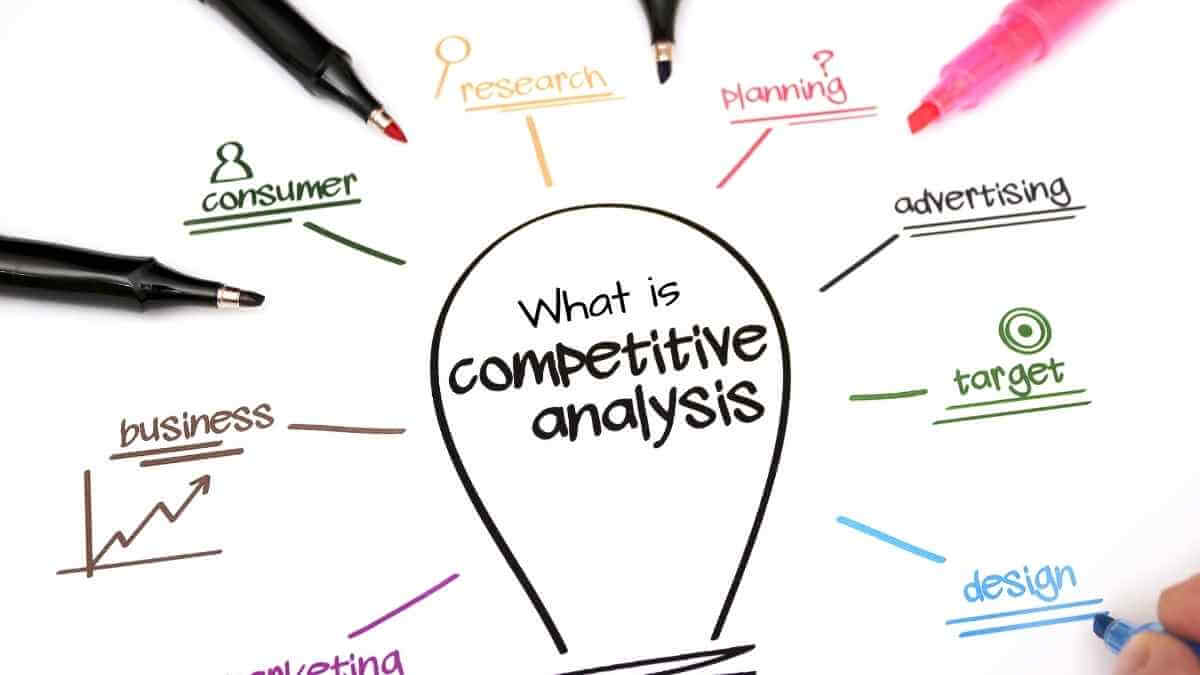I get it. If you’re a busy marketer, and you want to know what is competitive analysis, this blog is for you. No fluff here, just the essentials.
To help you out, I put together this cheat sheet of 7 facts about competitors that every marketer must know:
- Competitors are not only direct competitors but also indirect ones (Coke vs Pepsi vs water)
- Identify your competitors by looking at various websites such as Google search results, review sites (such as Yelp), competitor databases (like Owler), social media sites, and more.
- Check out the Search Engine Results Page (SERP) for your top keywords to see what competitors are up there too.
- Understand their content marketing strategy: Which channels do they use? What kind of content do they publish on them? How often? Who’s in charge of it? What kind of feedback does it generate?
- Look into their link-building strategy: Do they have any broken links? Any low-quality backlinks or spammy directories they should disavow ASAP? Are they getting backlinks from big publications in their niche?
- Observe how good their SEO is: What keywords do they target and how well do they rank for them? Are there any improvements that could be made to improve rankings further (on-page optimization, meta tags, etc.)?
- Do they use the right structure on their website so it can be crawled easily by search engines like Googlebot? … and much more!
As marketers, you need to keep your eyes open wide when doing competitive analysis because only then will you be able to spot opportunities for improvement and come up with innovative ways to differentiate your offer from theirs!
What is competitive analysis?

If you’re wondering what competition analysis is, it’s the process of gathering information about your competitors. You can use this information to help you understand their strengths and weaknesses, which will help you better plan for how to compete with them in the marketplace.
In other words, a competitor analysis gives you a better idea of who’s out there and what they’re doing so that when it comes time to launch your product or service into the world (or even just take a good hard look at your current operations), you know what needs improvement and where there may be growth opportunities.
Why do you need to do a competitive analysis?
A competitor is any business that provides a similar product or service to yours.
Competitive analysis can help you understand your competitors, their strengths and weaknesses, and how they’re performing in the market. This information will help you position yourself strategically against your competition and make decisions about where to allocate resources, who to target with your marketing campaigns, etc.
How does competition analysis help you?
Competitive analysis helps you understand your competitors better so that you can have a better understanding of the market. It also enables you to understand your customers better and allows you to gain a deeper understanding of your business, products, and services.
Competitive analysis is important because it allows businesses to assess their strengths and weaknesses compared with their competitors.
What is the process for conducting competitive analysis?
- Define the problem you are trying to solve.
- Set goals before you begin (and then revisit them regularly).
- Don’t worry about what other people’s goals are. Yours should come from within and be ambitious but realistic—don’t try to achieve something in 3 months that would take someone else 6 months or more!
How do you analyze your competitors’ strengths and weaknesses?
- The first step in competitive analysis is understanding your competitors’ strengths and weaknesses.
- This will help you identify any opportunities to improve your own business.
What are the steps to conduct a competitor analysis?
To conduct a competitor analysis, you must first research the market. You need to identify your competitors and understand their business model, strategy, and approach to the market.
- Research the market: Understand what is going on in your industry by researching your competitors’ websites or annual reports and also looking at industry trade magazines.
- Analyze the market: Once you’ve done your research, evaluate how each competitor operates in terms of products and services offered; customer base; distribution channels used; pricing strategies applied; marketing strategies implemented; sales force structure; collaborations with other firms such as suppliers or distributors, etc…
- Identify what’s working well for them and what isn’t working so well for them (and why).
- Identify your competitors: Include everything from direct competitors to indirect competitors targeting different segments within a broader category but still competing for some customers’ spending power (e.g., discount airlines versus low-cost airlines).
What is Competitive Analysis? How is it classified?
SWOT Analysis
The SWOT analysis is one of the most popular methods used in competitive analysis. It helps you evaluate your company’s relative strengths and weaknesses concerning the competition. Strengths are internal factors that contribute to a firm’s ability to compete, while weaknesses refer to internal factors that hinder a firm’s ability to compete.
Opportunities are external opportunities or threats which may or may not be beneficial for your business, but at least possible. Threats are external forces that can harm your business and prevent it from reaching its goals.
To determine whether an opportunity is an opportunity, consider if it will work for your company’s vision and overall strategy; if so, make sure that you have all necessary resources available before pursuing it further – this might include funding or expertise among others things depending on what kind of opportunity it is!
PEST Analysis
PEST stands for the Political, Economic, Social, and Technological factors that affect a business. PEST analysis is a tool used to help companies understand their external environment. A PEST analysis can give you information about any or all of these factors in your industry at any given time:
- Political – legislation, regulations, and government policies affecting your industry
- Economic – economic slowdowns; consumer spending habits; inflation rates; unemployment rates; interest rates
- Social – religious beliefs; cultural practices/traditions; family structure in society/geography where you do business
- Technological – technology (e.g., internet use) adoption rate.
Porter’s Five Forces
Porter’s Five Forces is a model that identifies and analyzes the competitive forces that shape every industry and helps determine an industry’s weaknesses and strengths.
The model is a framework that classifies five separate forces that shape competition in any given market.
These five forces are:
- The threat of new entrants into the marketplace
- The threat of substitute products or services (substitute goods/services)
- The bargaining power of suppliers
- The bargaining power of buyers (buyers’ market) – also referred to as “customer power” for consumers, or “distributor power” for wholesalers/retailers
- Rivalry among existing competitors within an industry.
Situation Analysis
Situation analysis is the first step in your competitive analysis. In this phase, you gain an understanding of the current situation in your industry. You want to identify key trends and factors that affect your business or product, such as:
- What are the current trends?
- What are the current market conditions?
- What are the current business conditions?
- What are the current economic conditions?
- What are the political conditions that could impact your organization or industry?
Competitive Analysis Matrix
The competitive analysis matrix is a tool to help you understand the strengths and weaknesses of your company compared to other competitors in your industry. It is a table that shows the company’s strengths and weaknesses concerning its competitors.
This tool can help you identify your competitors’ strengths and weaknesses, which can then be used for setting strategic goals, as well as measuring performance against those goals.
To create this matrix, you will need to consider all areas of competition—from customer service experience to product quality, price point, brand awareness, etc.—and rank each competitor by how well they do in each area relative to your own business.
Use competitive analysis to understand the strengths and weaknesses of your company compared to other competitors in your industry.
A well-designed competitive analysis will help you understand:
- What is happening in your market? Do you have a clear understanding of how competitors are positioning themselves and their products?
- How does this affect your business? Are there any new trends that could impact you, or opportunities for you to take advantage of? You can learn more about what’s happening in the market by analyzing competitive strategies, tactics, pricing models, and more.
To understand your business better, conduct a competitive analysis.
Competing against other businesses is a necessary part of the business. If you want to grow and succeed, you need to understand your competition. To do so, you should conduct a competition analysis.
- Competition analysis helps you understand your competitors better
- It helps you understand your business better
- It helps you understand your strengths and weaknesses
- It helps you understand your customers better
Conclusion
So, in short, what is competitive analysis, and how does it apply to your business? It can be both exciting and intimidating. The good news is that the task of collecting information about your competitors, along with analyzing it all to come up with new strategies, is something you don’t have to do yourself.

13+ Yrs Experienced Career Counsellor & Skill Development Trainer | Educator | Digital & Content Strategist. Helping freshers and graduates make sound career choices through practical consultation. Guest faculty and Digital Marketing trainer working on building a skill development brand in Softspace Solutions. A passionate writer in core technical topics related to career growth.

